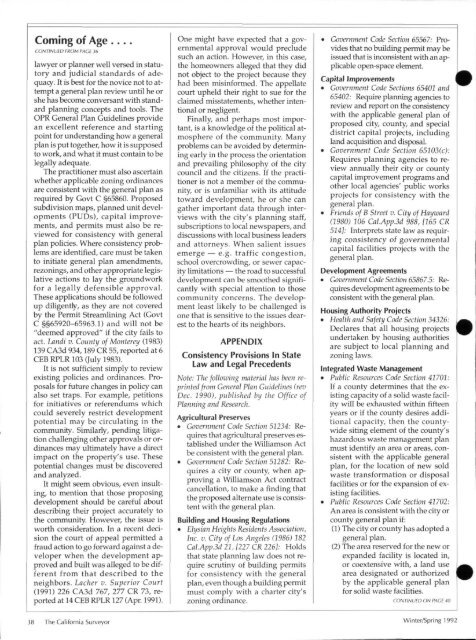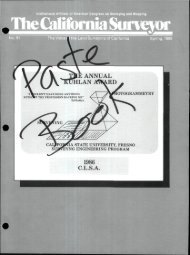Create successful ePaper yourself
Turn your PDF publications into a flip-book with our unique Google optimized e-Paper software.
Coming of Age<br />
CONTINUED FROM PACE 3b<br />
lawyer or planner well versed in statutory<br />
and judicial standards of adequacy.<br />
It is best <strong>for</strong> the novice not to attempt<br />
a general plan review until he or<br />
she has become conversant with standard<br />
planning concepts and tools. <strong>The</strong><br />
OPR General Plan Guidelines provide<br />
an excellent reference and starting<br />
point <strong>for</strong> understanding how a general<br />
plan is put together, how it is supposed<br />
to work, and what it must contain to be<br />
legally adequate.<br />
<strong>The</strong> practitioner must also ascertain<br />
whether applicable zoning ordinances<br />
are consistent with the general plan as<br />
required by Govt C §65860. Proposed<br />
subdivision maps, planned unit developments<br />
(PUDs), capital improvements,<br />
and permits must also be reviewed<br />
<strong>for</strong> consistency with general<br />
plan policies. Where consistency problems<br />
are identified, care must be taken<br />
to initiate general plan amendments,<br />
rezonings, and other appropriate legislative<br />
actions to lay the groundwork<br />
<strong>for</strong> a legally defensible approval.<br />
<strong>The</strong>se applications should be followed<br />
up diligently, as they are not covered<br />
by the Permit Streamlining Act (Govt<br />
C §§65920-65963.1) and will not be<br />
"deemed approved" if the city fails to<br />
act. Landi v. County of Monterey (1983)<br />
139 CA3d 934,189 CR 55, reported at 6<br />
CEB RPLR 103 (July 1983).<br />
It is not sufficient simply to review<br />
existing policies and ordinances. Proposals<br />
<strong>for</strong> future changes in policy can<br />
also set traps. For example, petitions<br />
<strong>for</strong> initiatives or referendums which<br />
could severely restrict development<br />
potential may be circulating in the<br />
community. Similarly, pending litigation<br />
challenging other approvals or ordinances<br />
may ultimately have a direct<br />
impact on the property's use. <strong>The</strong>se<br />
potential changes must be discovered<br />
and analyzed.<br />
It might seem obvious, even insulting,<br />
to mention that those proposing<br />
development should be careful about<br />
describing their project accurately to<br />
the community. However, the issue is<br />
worth consideration. In a recent decision<br />
the court of appeal permitted a<br />
fraud action to go <strong>for</strong>ward against a developer<br />
when the development approved<br />
and built was alleged to be different<br />
from that described to the<br />
neighbors. Lacher v. Superior Court<br />
(1991) 226 CA3d 767, 277 CR 73, reported<br />
at 14 CEB RPLR 127 (Apr. 1991).<br />
One might have expected that a governmental<br />
approval would preclude<br />
such an action. However, in this case,<br />
the homeowners alleged that they did<br />
not object to the project because they<br />
had been misin<strong>for</strong>med. <strong>The</strong> appellate<br />
court upheld their right to sue <strong>for</strong> the<br />
claimed misstatements, whether intentional<br />
or negligent.<br />
Finally, and perhaps most important,<br />
is a knowledge of the political atmosphere<br />
of the community. Many<br />
problems can be avoided by determining<br />
early in the process the orientation<br />
and prevailing philosophy of the city<br />
council and the citizens. If the practitioner<br />
is not a member of the community,<br />
or is unfamiliar with its attitude<br />
toward development, he or she can<br />
gather important data through interviews<br />
with the city's planning staff,<br />
subscriptions to local newspapers, and<br />
discussions with local business leaders<br />
and attorneys. When salient issues<br />
emerge — e.g. traffic congestion,<br />
school overcrowding, or sewer capacity<br />
limitations — the road to successful<br />
development can be smoothed significantly<br />
with special attention to those<br />
community concerns. <strong>The</strong> development<br />
least likely to be challenged is<br />
one that is sensitive to the issues dearest<br />
to the hearts of its neighbors.<br />
APPENDIX<br />
Consistency Provisions In State<br />
Law and Legal Precedents<br />
Note: <strong>The</strong> following material has been reprinted<br />
from General Plan Guidelines (rev<br />
Dec. 1990), published by the Office of<br />
Planning and Research.<br />
Agricultural Preserves<br />
• Government Code Section 51234: Requires<br />
that agricultural preserves established<br />
under the Williamson Act<br />
be consistent with the general plan.<br />
• Government Code Section 51282: Requires<br />
a city or county, when approving<br />
a Williamson Act contract<br />
cancellation, to make a finding that<br />
the proposed alternate use is consistent<br />
with the general plan.<br />
Building and Housing Regulations<br />
• Elysian Heights Residents Association,<br />
Inc. v. City of Los Angeles (1986) 182<br />
Cal.App.3d21,[227CR226]: Holds<br />
that state planning law does not require<br />
scrutiny of building permits<br />
<strong>for</strong> consistency with the general<br />
plan, even though a building permit<br />
must comply with a charter city's<br />
zoning ordinance.<br />
• Government Code Section 65567: Provides<br />
that no building permit may be<br />
issued that is inconsistent with an applicable<br />
open-space element.<br />
Capital Improvements<br />
• Government Code Sections 65401 and<br />
65402: Require planning agencies to<br />
review and report on the consistency<br />
with the applicable general plan of<br />
proposed city, county, and special<br />
district capital projects, including<br />
land acquisition and disposal.<br />
• Government Code Section 65103(c):<br />
Requires planning agencies to review<br />
annually their city or county<br />
capital improvement programs and<br />
other local agencies' public works<br />
projects <strong>for</strong> consistency with the<br />
general plan.<br />
• Friends of B Street v. City of Hayzvard<br />
(1980) 106 Cal.App.3d 988, [165 CR<br />
514]: Interprets state law as requiring<br />
consistency of governmental<br />
capital facilities projects with the<br />
general plan.<br />
Development Agreements<br />
• Government Code Section 65867.5: Requires<br />
development agreements to be<br />
consistent with the general plan.<br />
Housing Authority Projects<br />
• Health and Safety Code Section 34326:<br />
Declares that all housing projects<br />
undertaken by housing authorities<br />
are subject to local planning and<br />
zoning laws.<br />
Integrated Waste Management<br />
• Public Resources Code Section 41701:<br />
If a county determines that the existing<br />
capacity of a solid waste facility<br />
will be exhausted within fifteen<br />
years or if the county desires additional<br />
capacity, then the countywide<br />
siting element of the county's<br />
hazardous waste management plan<br />
must identify an area or areas, consistent<br />
with the applicable general<br />
plan, <strong>for</strong> the location of new sold<br />
waste trans<strong>for</strong>mation or disposal<br />
facilities or <strong>for</strong> the expansion of existing<br />
facilities.<br />
• Public Resources Code Section 41702:<br />
An area is consistent with the city or<br />
county general plan if:<br />
(1) <strong>The</strong> city or county has adopted a<br />
general plan.<br />
(2) <strong>The</strong> area reserved <strong>for</strong> the new or<br />
expanded facility is located in,<br />
or coextensive with, a land use<br />
area designated or authorized<br />
by the applicable general plan<br />
<strong>for</strong> solid waste facilities.<br />
CONTINUED ON PACE 40<br />
38 <strong>The</strong> Cali<strong>for</strong>nia <strong>Surveyor</strong> Winter/Spring 1992
















